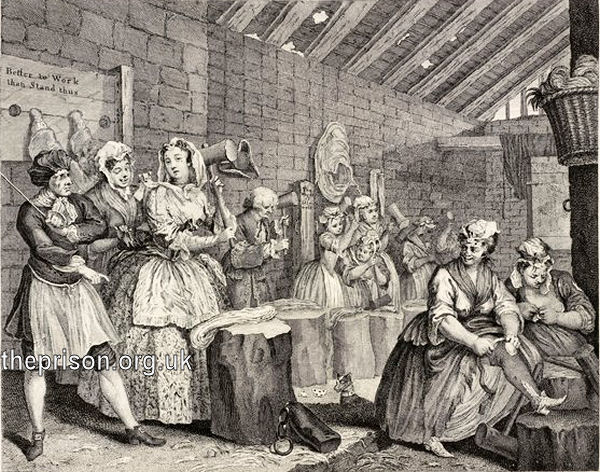Women in Prison
Special accommodation for female prisoners existed as early as the thirteenth century. In 1237, a proposal was made to establish a women's gaol within the York Castle and by 1280 a chamber for female inmates existed at Maidstone. In around 1310, after a lengthy campaign by the Chancellor of Oxford University, a separate women's section was created at the town gaol. Later known as the 'maiden's chamber', it was mostly used to house prostitutes.
By1724, Newgate had separate areas for female inmates. On the Common Side, women unable to pay their prison fees were placed in the Waterman's Hall, a 'very terrible, dark and stinking Place'. Although supplied with fresh water via a lead cistern, inmates had to sleep on the wooden floor. In another ward, for short-term housing of those awaiting transportation, the women were 'almost poisoned by their own filth'.
Women prisoners were particularly vulnerable to exploitation by both prison staff and male inmates. During his time in the King's Bench in 1617-18, Geffray Mynshul, commented that 'a whore entering into a prison is a hony-pot, about which all the flyes come buzzing, as crowes to a carrion.'
A potential reprieve for females facing the death penalty was known as the 'benefit of the belly'. A woman declaring herself to be pregnant would not be hanged until after the birth of her innocent child. However, the sentence was rarely then carried out and effectively resulted in a pardon. Although such claims of pregnancy were supposed to be verified by a midwife, it seems doubtful whether this was taken seriously. Between 1559 and 1625, 38 per cent of convicted female felons in one court circuit successfully claimed that they were expecting. At Newgate, women awaiting execution were placed together in a large ward on the top floor from where the widespread and open soliciting for men to provide this means of reprieve was known to shock visitors to the prison.
The scene below is from Hogarth's 1732 sequence A Harlot's Progress. Following her descent into prostitution, Moll Hackabout (third from left) has been placed by magistrates in London's Bridewell prison. The gaoler (left) directs her to beat hemp — used to make hangman's nooses. The gaoler's wife tries to steal Moll's clothes, while Moll's smiling servant (second from right) appears already to have acquired her shoes. Other prisoners include a card-sharp and a pregnant African woman who may have pleaded 'benefit of the belly' — pregnant women could not be executed. A (presumably idle) man is being held in a pillory beneath the legend 'Better to Work than Stand thus'.

Prison scene from A Harlot's progress, 1732.
Robert Peel's Gaol Act of 1823 required that male and female prisoners were to be housed separately and that women should be supervised only by female warders.
In 1853, with the introduction of sentences of penal servitude, the former county bridewell at Brixton was re-opened as the Brixton Female Convict Prison. The inmates were removed in 1869 to the first purpose-built female prison at Woking.
In 1856, Fulham Refuge was opened to receive female convicts during the last stage of their sentence, and provide training for future employment in skills such as cooking, cleaning and laundry, with and emphasis on "softening and civilising". The labelling of the prison as a 'Refuge' — a term then also used to describe establishments receiving young women who were considered in moral danger — was intended to make potential employers less reluctant to employ it former inmates. The prison was closed in 1888, and the remaining inmates were again transferred to Woking Prison.
In 1895, following the conversion of the former Aylesbury County Gaol into a prison for adult female convicts, it received all of Woking's female inmates.
Up until around 1900, all local prisons — with the exception of London's Pentonville and Wandsworth — included accommodation for female inmates. In 1902, London's Holloway Prison became the first all-women local prison in England, and the only one in London receiving females.
Bibliography
- Higginbotham, Peter The Prison Cookbook: A History of the English Prison and its Food (2010, The History Press)
- Brodie, A. Behind Bars - The Hidden Architecture of England's Prisons (2000, English Heritage)
- Brodie, A., Croom, J. & Davies, J.O. English Prisons: An Architectural History (2002, English Heritage)
- Harding, C., Hines, B., Ireland, R., Rawlings, P. Imprisonment in England and Wales (1985, Croom Helm)
- McConville, Sean A History of English Prison Administration: Volume I 1750-1877 (1981, Routledge & Kegan Paul)
- Morris, N. and Rothman, D.G. (eds.) The Oxfod History of the Prison (1997, OUP)
- Pugh R.B. Imprisonment in Medieval England (1968, CUP)
Links
- Prison Oracle - resources those involved in present-day UK prisons.
- GOV.UK - UK Government's information on sentencing, probation and support for families.
Except where indicated, this page () © Peter Higginbotham. Contents may not be reproduced without permission.



